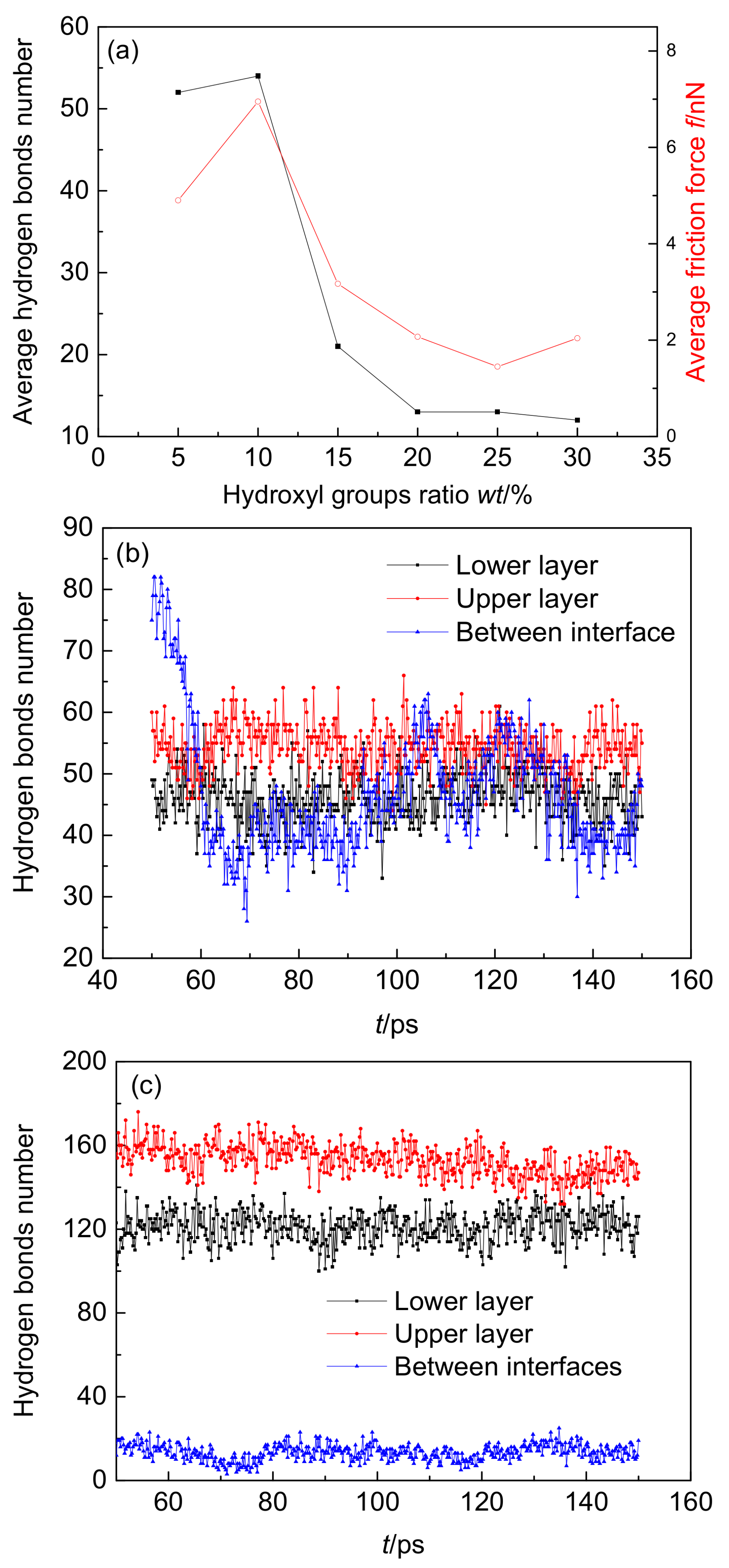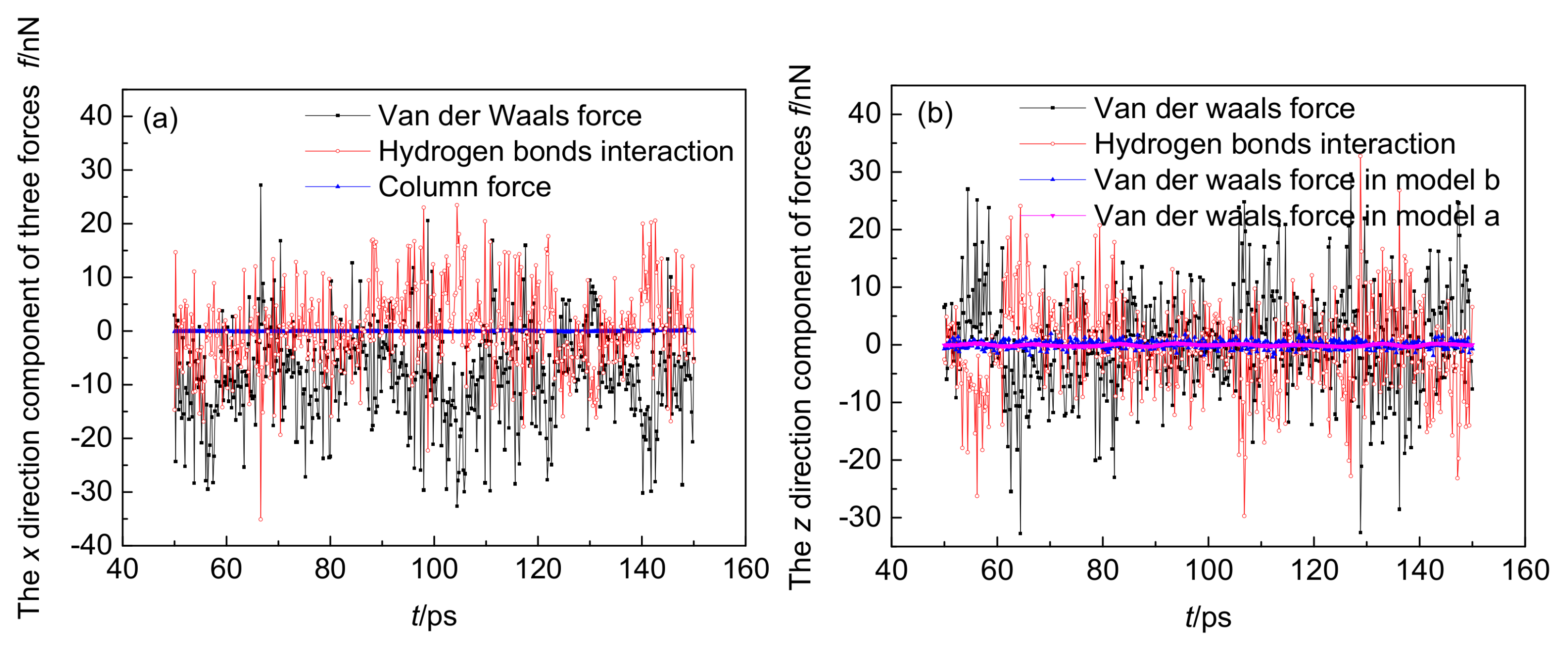The Influence of Hydroxyl Groups on Friction of Graphene at Atomic Scale
Abstract
:1. Introduction
2. Simulation Model
3. Results and Discussion
4. Conclusions
Acknowledgments
Author Contributions
Conflicts of Interest
References
- Zhu, Y.W.; Murali, S.; Cai, W.W.; Li, X.S.; Suk, J.W.; Potts, J.R.; Ruoff, R.S. Graphene and Graphene Oxide: Synthesis, Properties, and Applications. Adv. Mater. 2010, 22, 5226. [Google Scholar] [CrossRef]
- Robinson, J.T.; Zalalutdinov, M.; Baldwin, J.W.; Snow, E.S.; Wei, Z.Q.; Sheehan, P.; Houston, B.H. Wafer-scale Reduced Graphene Oxide Films for Nanomechanical Devices. Nano Lett. 2008, 8, 3441–3445. [Google Scholar] [CrossRef] [PubMed]
- Li, X.M.; Tao, L.; Chen, Z.F.; Fang, H.; Li, X.S.; Wang, X.R.; Xu, J.B.; Zhu, H.W. Graphene and related two-dimensional materials: Structure-property relationships for electronics and optoelectronics. Appl. Phys. Rev. 2017, 4, 021306. [Google Scholar] [CrossRef]
- Gupta, B.; Kumar, N.; Panda, K.; Kanan, V.; Joshi, S.; Visoly-Fisher, I. Role of oxygen functional groups in reduced graphene oxide for lubrication. Sci. Rep. 2017, 7, 45030. [Google Scholar] [CrossRef] [PubMed]
- Lee, C.; Li, Q.Y.; Kalb, W.; Liu, X.Z.; Berger, H.; Carpick, R.W.; Hone, J. Frictional Characteristics of Atomically Thin Sheets. Science 2010, 328, 76–80. [Google Scholar] [CrossRef] [PubMed]
- Long, F.; Yasaei, P.; Yao, W.; Salehi-Khojin, A.; Shahbazian-Yassar, R. Anisotropic Friction of Wrinkled Graphene Grown by Chemical Vapor Deposition. ACS Appl. Mater. Interfaces 2017, 9, 20922–20927. [Google Scholar] [CrossRef] [PubMed]
- Shi, R.Y.; Gao, L.; Lu, H.L.; Li, Q.Y.; Ma, T.B.; Guo, H.; Du, S.X.; Feng, X.Q.; Zhang, S.; Liu, Y.M.; et al. Moire superlattice-level stick-slip instability originated from geometrically corrugated graphene on a strongly interacting substrate. 2D Mater. 2017, 4, 025079. [Google Scholar] [CrossRef]
- Lee, C.; Wei, X.D.; Li, Q.Y.; Carpick, R.; Kysar, J.W.; Hone, J. Elastic and frictional properties of graphene. Phys. Status Solidi B Basic Solid State Phys. 2009, 246, 2562–2567. [Google Scholar] [CrossRef]
- Grierson, D.S.; Carpick, R.W. Nanotribology of carbon-based materials. Nano Today 2007, 2, 12–21. [Google Scholar] [CrossRef]
- Ismail, N.A.; Bagheri, S. Highly oil-dispersed functionalized reduced graphene oxide nanosheets as lube oil friction modifier. Mater. Sci. Eng. B-Adv. Funct. Solid State Mater. 2017, 222, 34–42. [Google Scholar] [CrossRef]
- Wei, Z.; Wang, D.; Kim, S.; Kim, S.-Y.; Hu, Y.; Yakes, M.K.; Laracuente, A.R.; Dai, Z.; Marder, S.R.; Berger, C.; et al. Nanoscale Tunable Reduction of Graphene Oxide for Graphene Electronics. Science 2010, 328, 1373–1376. [Google Scholar] [CrossRef] [PubMed]
- Byun, I.S.; Yoon, D.; Choi, J.S.; Hwang, I.; Lee, D.H.; Lee, M.J.; Kawai, T.; Son, Y.W.; Jia, Q.; Cheong, H.; et al. Nanoscale Lithography on Mono layer Graphene Using Hydrogenation and Oxidation. ACS Nano 2011, 5, 6417–6424. [Google Scholar] [CrossRef] [PubMed]
- Berman, D.; Erdemir, A.; Zinovev, A.V.; Sumant, A.V. Nanoscale friction properties of graphene and graphene oxide. Diam. Relat. Mat. 2015, 54, 91–96. [Google Scholar] [CrossRef]
- Dong, Y.L.; Wu, X.W.; Martini, A. Atomic roughness enhanced friction on hydrogenated graphene. Nanotechnology 2013, 24, 137–144. [Google Scholar] [CrossRef] [PubMed]
- Kwon, S.; Ko, J.H.; Jeon, K.J.; Kim, Y.H.; Park, J.Y. Enhanced Nanoscale Friction on Fluorinated Graphene. Nano Lett. 2012, 12, 6043–6048. [Google Scholar] [CrossRef] [PubMed]
- Ko, J.H.; Kwon, S.; Byun, I.S.; Choi, J.S.; Park, B.H.; Kim, Y.H.; Park, J.Y. Nanotribological Properties of Fluorinated, Hydrogenated, and Oxidized Graphenes. Tribol. Lett. 2013, 50, 137–144. [Google Scholar] [CrossRef]
- Medhekar, N.V.; Ramasubramaniam, A.; Ruoff, R.S.; Shenoy, V.B. Hydrogen Bond Networks in Graphene Oxide Composite Paper: Structure and Mechanical Properties. ACS Nano 2010, 4, 2300–2306. [Google Scholar] [CrossRef] [PubMed]
- Wang, L.F.; Ma, T.B.; Hu, Y.Z.; Wang, H. Atomic-scale friction in graphene oxide: An interfacial interaction perspective from first-principles calculations. Phys. Rev. B 2012, 86, 1595–1599. [Google Scholar] [CrossRef]
- Duong, D.L.; Kim, G.; Jeong, H.K.; Lee, Y.H. Breaking AB stacking order in graphite oxide: Ab initio approach. Phys. Chem. Chem. Phys. 2010, 12, 1595–1599. [Google Scholar] [CrossRef] [PubMed]
- Lahaye, R.; Jeong, H.K.; Park, C.Y.; Lee, Y.H. Density functional theory study of graphite oxide for different oxidation levels. Phys. Rev. B 2009, 79, 623–630. [Google Scholar] [CrossRef]
- Li, A.; Liu, Y.; Szlufarska, I. Effects of Interfacial Bonding on Friction and Wear at Silica/Silica Interfaces. Tribol. Lett. 2014, 56, 481–490. [Google Scholar] [CrossRef]
- Erbas, A.; Horinek, D.; Netz, R.R. Viscous Friction of Hydrogen-Bonded Matter. J. Am. Chem. Soc. 2012, 134, 623–630. [Google Scholar] [CrossRef] [PubMed]
- Brenner, D.W.; Shenderova, O.A.; Harrison, J.A.; Stuart, S.J.; Ni, B.; Sinnott, S.B. A second-generation reactive empirical bond order (REBO) potential energy expression for hydrocarbons. J. Phys. Condes. Matter 2002, 14, 783–802. [Google Scholar] [CrossRef]
- Hughes, Z.E.; Shearer, C.J.; Shapter, J.; Gale, J.D. Simulation of Water Transport through Functionalized Single-Walled Carbon Nanotubes (SWCNTs). J. Phys. Chem. C 2012, 116, 24943–24953. [Google Scholar] [CrossRef]
- Damm, W.; Frontera, A.; Tirado-Rives, J.; Jorgensen, W.L. OPLS all-atom force field for carbohydrates. J. Comput. Chem. 1997, 18, 1955–1970. [Google Scholar] [CrossRef]
- Kony, D.; Damm, W.; Stoll, S.; van Gunsteren, W.F. An improved OPLS-AA force field for carbohydrates. J. Comput. Chem. 2002, 23, 1416–1429. [Google Scholar] [CrossRef] [PubMed]
- Ruoff, R.S.; Hickman, A.P. Van der Waals binding of fullerenes to a graphite plane. J. Phys. Chem. 1993, 97, 2494–2496. [Google Scholar] [CrossRef]
- Mayo, S.L.; Olafson, B.D.; Goddard, W.A., III. Dreiding: A generic force field for molecular simulations. J. Phys. Chem. 1990, 94, 8897–8909. [Google Scholar] [CrossRef]
- Plimpton, S. Fast Parallel Algorithms for Short-Range Molecular Dynamics. J. Comput. Phys. 1995, 117, 1–19. [Google Scholar] [CrossRef]
- Wu, X.W.; Moon, R.J.; Martini, A. Atomistic Simulation of Frictional Sliding Between Cellulose I beta Nanocrystals. Tribol. Lett. 2013, 52, 395–405. [Google Scholar] [CrossRef]




© 2018 by the authors. Licensee MDPI, Basel, Switzerland. This article is an open access article distributed under the terms and conditions of the Creative Commons Attribution (CC BY) license (http://creativecommons.org/licenses/by/4.0/).
Share and Cite
Li, R.; Song, C. The Influence of Hydroxyl Groups on Friction of Graphene at Atomic Scale. Crystals 2018, 8, 167. https://doi.org/10.3390/cryst8040167
Li R, Song C. The Influence of Hydroxyl Groups on Friction of Graphene at Atomic Scale. Crystals. 2018; 8(4):167. https://doi.org/10.3390/cryst8040167
Chicago/Turabian StyleLi, Rui, and Chenggang Song. 2018. "The Influence of Hydroxyl Groups on Friction of Graphene at Atomic Scale" Crystals 8, no. 4: 167. https://doi.org/10.3390/cryst8040167




